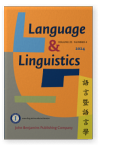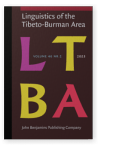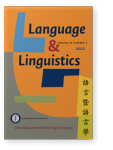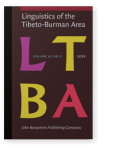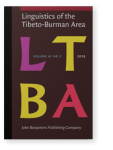Jesse P. Gates
List of John Benjamins publications for which Jesse P. Gates plays a role.
2024 Anticausativization in Gyalrongic languages Studies in Language: Online-First Articles | Article
This article presents a comprehensive survey of anticausativization within Gyalrongic languages, a group of Sino-Tibetan languages spoken in Sichuan, China, contributing significantly to our understanding of this phenomenon’s theoretical and diachronic underpinnings. The research affirms that… read more
2024 A voicing rule for non-continuant obstruents in Thebo Tibetan Language and Linguistics 25:4, pp. 710–746 | Article
Voicing alternation and the function of Tibetan verbal prefixes are two problems that have attracted scholars of Tibetan and Sino-Tibetan linguistics for over a century. This article presents a voicing rule in Thebo Tibetan and systematically analyzes the verb paradigm to explain the constraints… read more
2023 Kinship terms in Stau Linguistics of the Tibeto-Burman Area 46:2, pp. 265–289 | Article
This paper presents a comprehensive synchronic study of Stau kinship terms, offering a detailed analysis of their classifications and characteristics. Stau kinship terms are categorized into vocative and referential/possessive forms. Vocative kinship terms follow the intonation pattern of other… read more
2022 From transitive to intransitive and voiceless to voiced in Proto-Sino-Tibetan: New evidence from Stau, Geshiza, and Khroskyabs Language and Linguistics 23:2, pp. 212–239 | Article
This paper offers new evidence from Stau, Geshiza, and Khroskyabs to address the question of directionality in valency-changing derivations in Sino-Tibetan. Examining Stau, Geshiza, and Khroskyabs causative and anticausative verb stem pairs adds to the evidence that in Proto-Sino-Tibetan, a… read more
2019 Relativization in Guiqiong Linguistics of the Tibeto-Burman Area 42:2, pp. 260–279 | Article
Guiqiong, like most Sino-Tibetan languages, presents a rich array of relativization constructions. Based on both natural oral texts and elicited material, the present paper describes all attested types of relatives in Guiqiong, including prenominal, head-internal, headless, and double-headed… read more
2018 Vowel harmony in Stau Linguistics of the Tibeto-Burman Area 41:2, pp. 263–293 | Article
In this paper, we propose that in Stau (Rgyalrongic, Sino-Tibetan) there is a system of four vowel pairs (/i/-/ə/, /e/-/ɛ/, /æ/-/ɑ/, /u/-/o/) that undergo regressive vowel harmony. This system of vowel harmony produces root morpheme forms such as [æCæ] and [ɑCɑ], whereas forms like [æCɑ] or… read more
